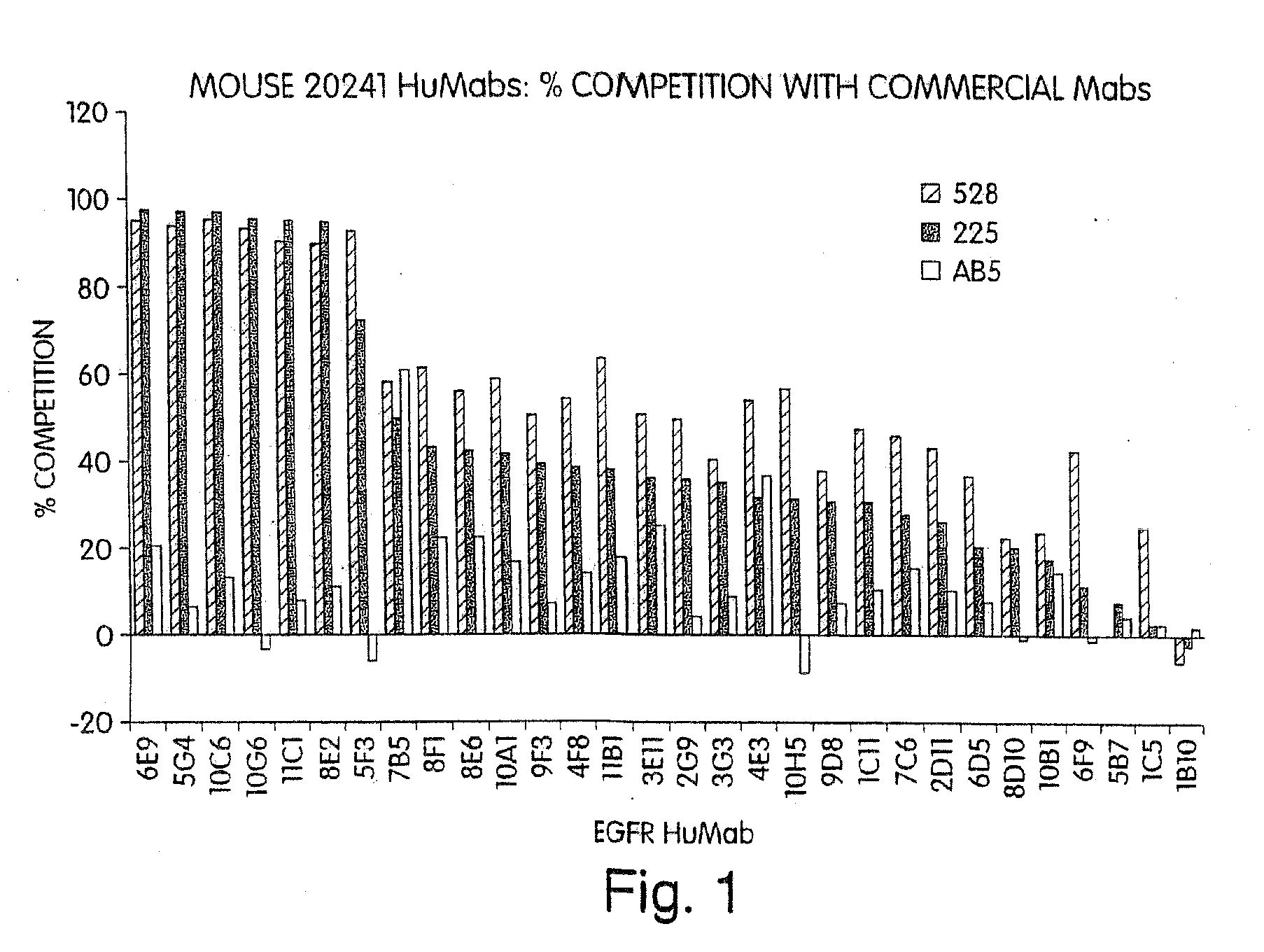Human monoclonal antibodies to epidermal growth factor receptor (EGFR)
a growth factor receptor and human monoclonal antibody technology, applied in antibody medical ingredients, immunological disorders, metabolism disorders, etc., can solve the problems of murine antibodies not being ideal therapeutic agents, severe immune reactions in patients, murine antibodies generally triggering, etc., to prevent growth and/or function, less immunogenic patients, and low dosage
- Summary
- Abstract
- Description
- Claims
- Application Information
AI Technical Summary
Benefits of technology
Problems solved by technology
Method used
Image
Examples
example 1
Generation of Cmu Targeted Mice for the Production of Anti-EGFR Human Antibodies, Also Referred to as “HuMabs”
Construction of a CMD Targeting Vector
[0295]The plasmid pICEmu contains an EcoRI / XhoI fragment of the murine Ig heavy chain locus, spanning the mu gene, that was obtained from a Balb / C genomic lambda phage library (Marcu et al. Cell 22: 187, 1980). This genomic fragment was subcloned into the XhoI / EcoRI sites of the plasmid pICEMI9H (Marsh et al; Gene 32, 481-485, 1984). The heavy chain sequences included in pICEmu extend downstream of the EcoRI site located just 3′ of the mu intronic enhancer, to the XhoI site located approximately 1 kb downstream of the last transmembrane exon of the mu gene; however, much of the mu switch repeat region has been deleted by passage in E. coli. The targeting vector was constructed as follows. A 1.3 kb HindIII / SmaI fragment was excised from pICEmu and subcloned into HindIII / SmaI digested pBluescript (Stratagene, La Jolla, Calif.). This pICEmu...
example 2
Generation of HCO12 Transgenic Mice for the Production of Anti-EGFR Human Antibodies
The HCO12 Human Heavy Chain Transgene
[0301]The HCO12 transgene was generated by coinjection of the 80 kb insert of pHC2 (Taylor et al., 1994, Int. Immunol., 6: 579-591) and the 25 kb insert of pV×6. The plasmid pV×6 was constructed as described below.
[0302]An 8.5 kb HindIII / SalI DNA fragment, comprising the germline human VH1-18 (DP-14) gene together with approximately 2.5 kb of 5′ flanking, and 5 kb of 3′ flanking genomic sequence was subcloned into the plasmid vector pSP72 (Promega, Madison, Wis.) to generate the plasmid p343.7.16. A 7 kb BamHI / HindIII DNA fragment, comprising the germline human VH5-51 (DP-73) gene together with approximately 5 kb of 5′ flanking and 1 kb of 3′ flanking genomic sequence, was cloned into the pBR322 based plasmid cloning vector pGP1f (Taylor et al. 1992, Nucleic Acids Res. 20: 6287-6295), to generate the plasmid p251f. A new cloning vector derived from pGP1f, pGP1k, w...
example 3
Production of Human Monoclonal Antibodies Against EGFR
[0303]Two different strains of mice were used to generate EGFR reactive human monoclonal antibodies. Strain ((CMD)++; (JKD)++; (HCo7)11952+ / ++; (KCo5)9272+ / ++) (referred to herein as “HCO7 mice”, and strain ((CMD)++; (JKD)++; (HCo12)15087+ / ++; (KCo5)9272+ / ++) (referred to herein as “HCO12 mice”). Each of these strains are homozygous for disruptions of the endogenous heavy chain (CMD) and kappa light chain (JKD) loci. Both strains also comprise a human kappa light chain transgene (HCo7), with individual animals either hemizygous or homozygous for insertion #11952. The two strains differ in the human heavy chain transgene used. Mice were hemizygous or homozygous for either the HCo7 or the HCo12 transgene. The CMD mutation is described above in Example 1. The generation of (HCo12)15087 mice is described in Example 2. The JKD mutation (Chen et al. 1993, EMBO J. 12: 811-820) and the (KCo5)9272 (Fishwild et al. 1996, Nature Biotechnolo...
PUM
| Property | Measurement | Unit |
|---|---|---|
| concentration | aaaaa | aaaaa |
| temperature | aaaaa | aaaaa |
| volume | aaaaa | aaaaa |
Abstract
Description
Claims
Application Information
 Login to View More
Login to View More - R&D
- Intellectual Property
- Life Sciences
- Materials
- Tech Scout
- Unparalleled Data Quality
- Higher Quality Content
- 60% Fewer Hallucinations
Browse by: Latest US Patents, China's latest patents, Technical Efficacy Thesaurus, Application Domain, Technology Topic, Popular Technical Reports.
© 2025 PatSnap. All rights reserved.Legal|Privacy policy|Modern Slavery Act Transparency Statement|Sitemap|About US| Contact US: help@patsnap.com



